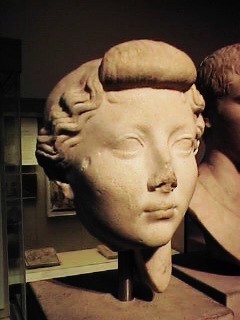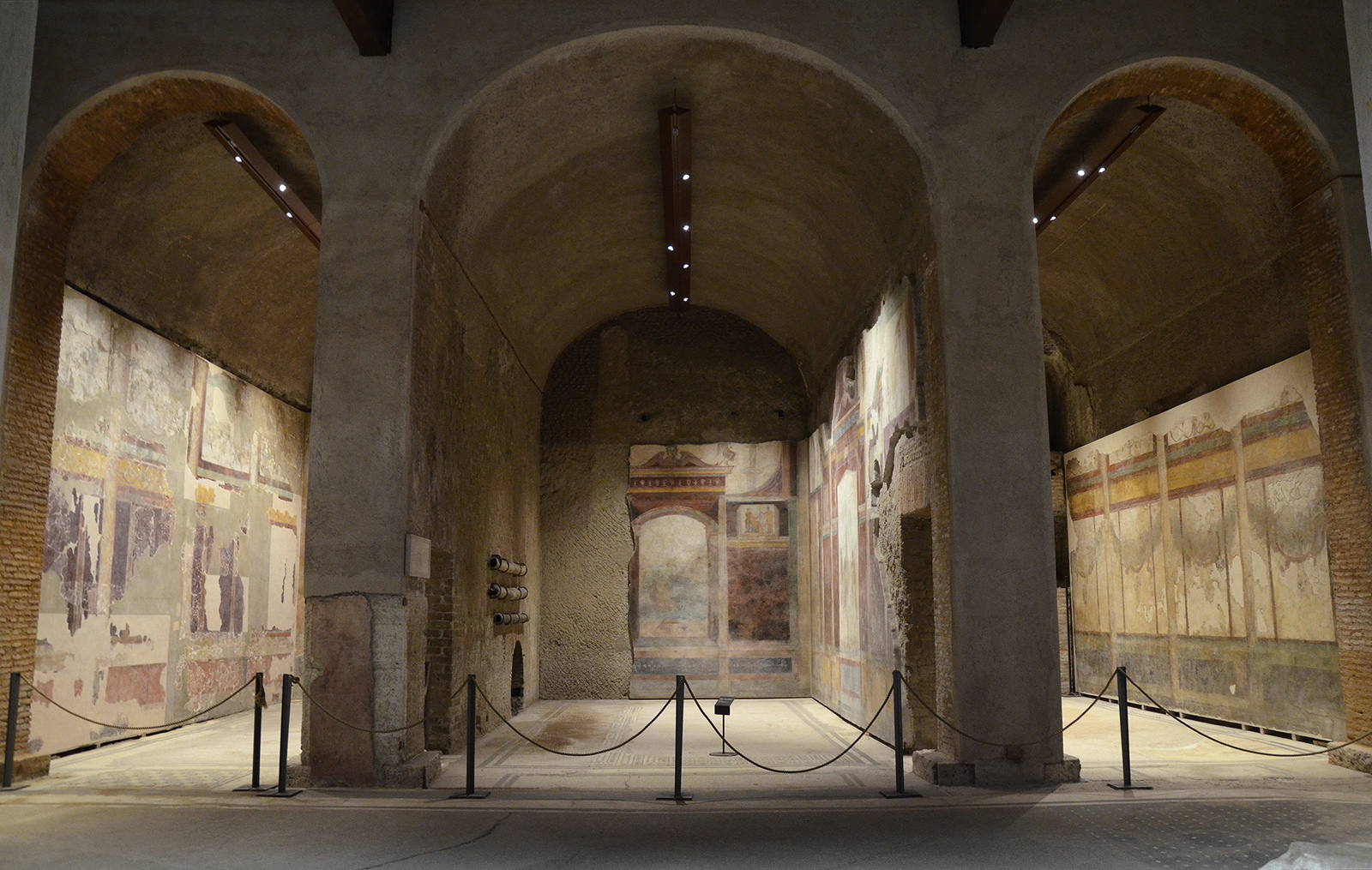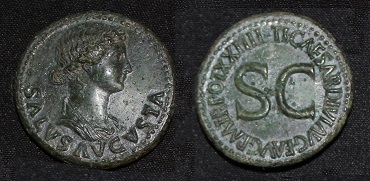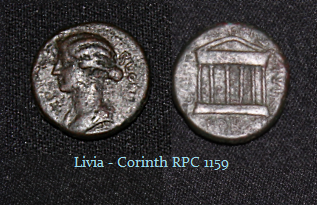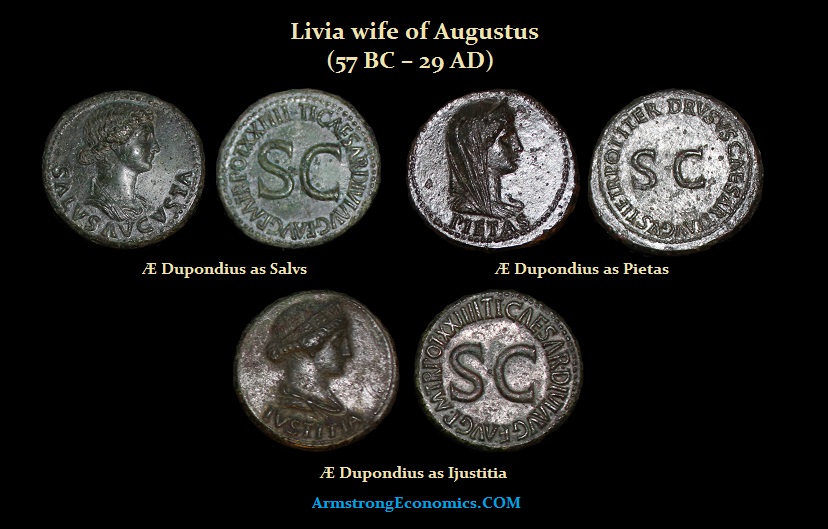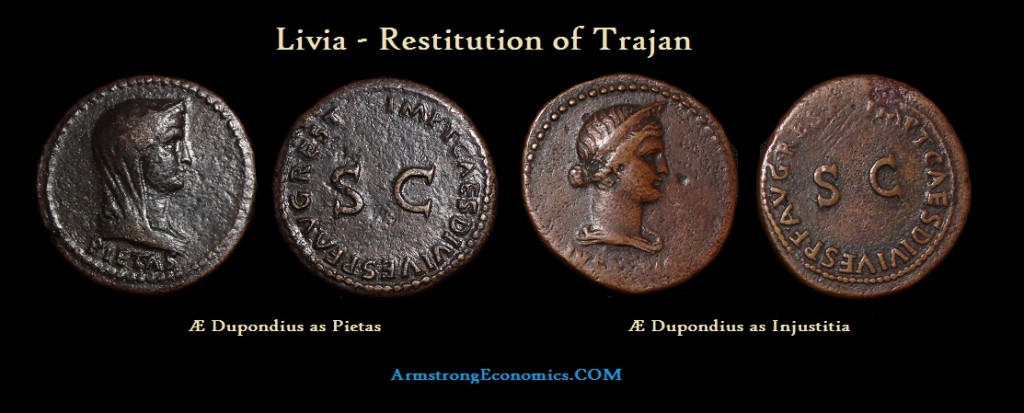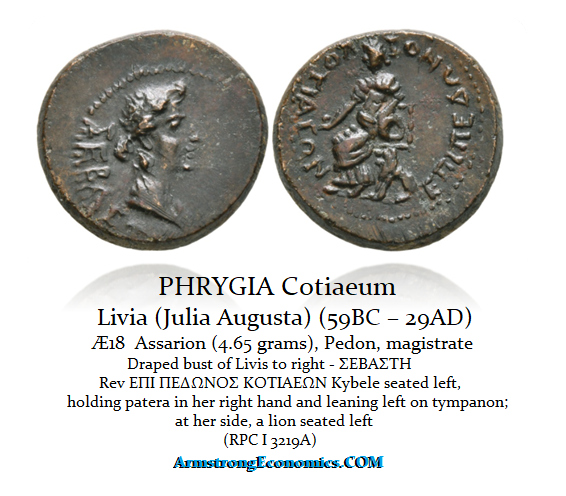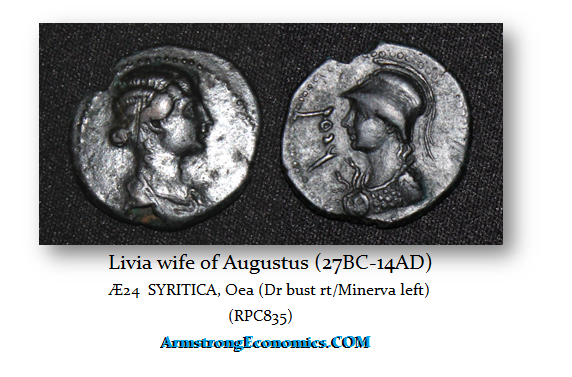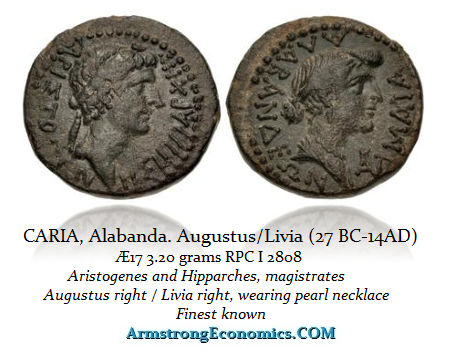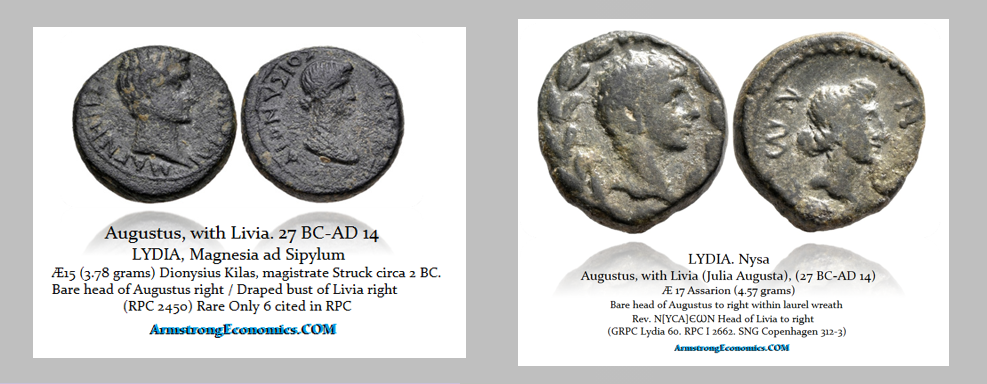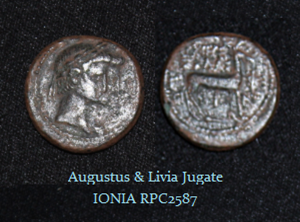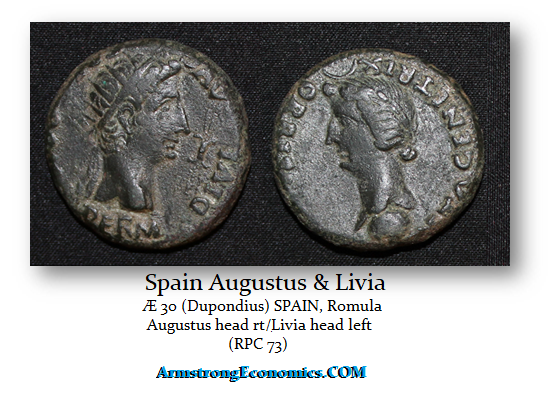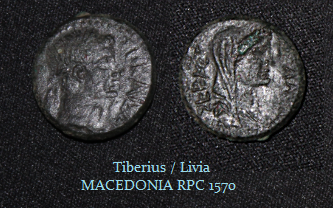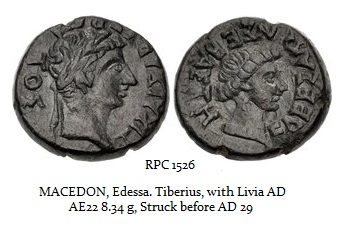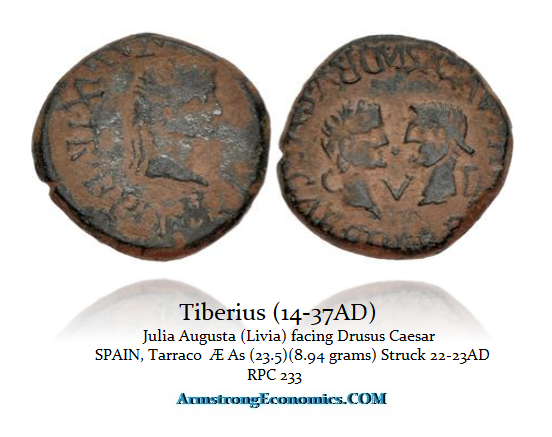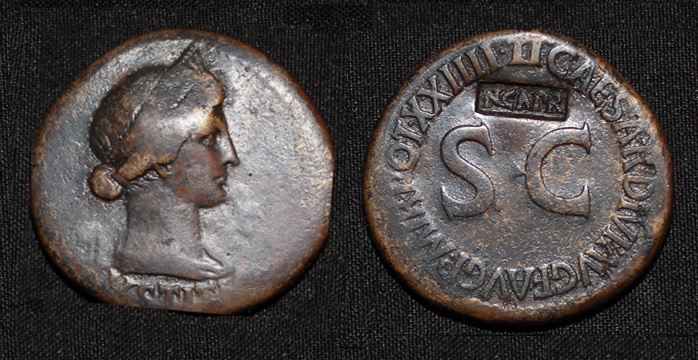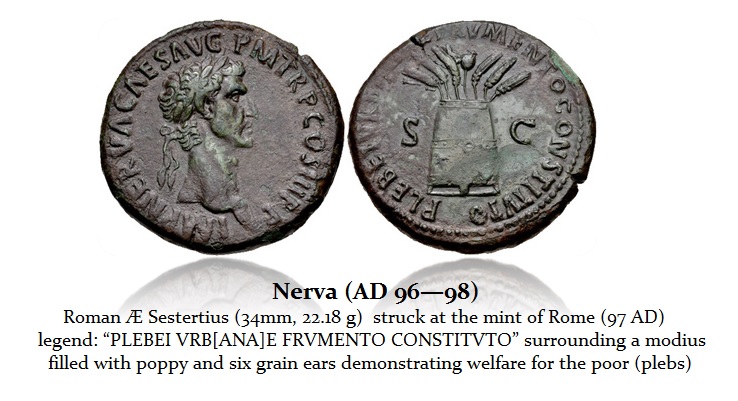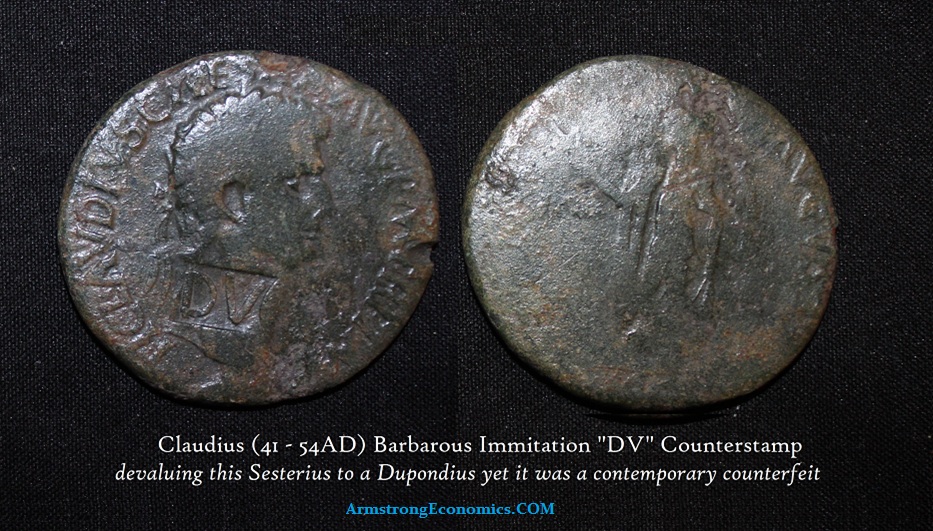Livia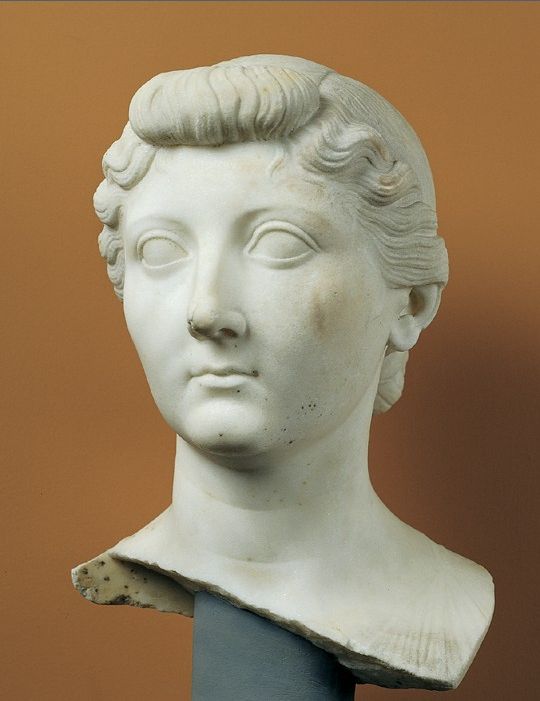
wife of Augustus
mother of Tiberius & the nation
born 57 BC – died 29 AD at the age of 86
Livia Drusilla was a woman of renowned beauty in her day. Livia was the daughter of a nobleman named Marcus Livius Drusus Claudius and his wife Alfidia. Livia Drusilla was born on January 30th, 59 BC. Her name, Drusilla, suggests she was not her father’s first daughter.
Her father was a Republican who opposed Julius Caesar. She was first married around 43BC to a Republican, Tiberius Claudius Nero (c. 82 – 33 BC), who supported the assassins of Julius Caesar.
Her father committed suicide in the Battle of Philippi, along with Gaius Cassius Longinus and Marcus Junius Brutus. Her husband fled and took refuge with Sextus Pompey, who was in Sicily. After an amnesty from Octavian, they returned to Rome when their son Tiberius was three years old.
Palace of Augustus and Livia
 Livia divorced her husband, and she was immediately married to Octavian/Augustus in January of 38 BC while she was pregnant with her second son, Drusus. She never bore any children with Augustus.
Livia divorced her husband, and she was immediately married to Octavian/Augustus in January of 38 BC while she was pregnant with her second son, Drusus. She never bore any children with Augustus.
According to Tacitus, Livia won a reputation for generosity and encouraged Augustus to show clemency towards his opponents. She was also quite tolerant of his numerous infidelities. Livia appears to have been loyal to Augustus, seeking the pleasures of power rather than those of the flesh.
Livia, however, comes to us through history with a reputation as a secretive and cunning woman. Livia was suspected of murder and intrigue in pursuit of her obsession with establishing a “Claudian” dynasty. She was accused by historians of procuring the deaths of Marcus Claudius Marcellus (42–23BC) who was the son of Augustus’ sister Octavia, Gaius, and Lucius (sons of Agrippa & Julia) in order to secure the position of her own son, Tiberius, as heir to the newly found throne.
The most shocking accusation against Livia focuses upon the death of Augustus himself. In the last few months before he died, Augustus is believed to have suspected Livia’s invisible hand in securing the path to the throne. Augustus made a secret visit to Planasia where his last surviving grandson, Agrippa Postumus had been sent into exile by Augustus years before. Livia may have suspected that Augustus was about to be reinstated Agrippa Postumus as a rival to Tiberius or perhaps the preferred heir to the empire. To prevent any such occurrence, Livia is said to have . . .
“smeared with poison some figs that were still on trees from which Augustus was wont to gather the fruit with his own hands; then she ate those that had not been smeared, offering the poisoned ones to him.”

Livia survived her husband Augustus by some 15 years. Her political influence increased considerably under her son’s rule, and her bust was set up in the Temple of Alexandria. She was given the title of Julia Augusta and possessed equal authority with that of Tiberius. Livia was likely instrumental in ordering the death of Agrippa Postumus, and she clearly engaged in a fierce feud with the wife of Germanicus, Agrippina. Perhaps to counter her growing reputation for ruthlessness, Livia strongly protected Caligula, the last surviving son of Germanicus, who surely would have been murdered by the ambitious Prefect of the Praetorian Guard – Sejanus. She also saved many senators during this same reign of terror organized by Sejanus under the name of Tiberius. Furthermore, she did much to benefit the children of Rome and helped Roman women with the dowries.
Mausoleum of Augustus & Livia
Livia died in 29 AD. Upon her death, the Senate of Rome bestowed upon her all possible honors, including ordering the construction of an arch. Tiberius vetoed that order claiming that he himself wanted to construct such a monument but never did. Tiberius, still very resentful of his mother, also refused to deify her. It was not until Claudius became Emperor that Livia was finally defied in 42 AD. She was, of course, buried in Augustus’ mausoleum.
Monetary System
Livia as Salvs on AE Dupondius
When Livia served as Empress of Rome, tradition had not yet developed where the portrait of a woman would appear on the coinage. Consequently, the coinage with Latin legends displays the portrait of Livia as a god, similar in fashion to Pompey’s likeness, which was applied to the portrait of the Roman god Janus on the bronze As issued during the Civil War. Portrait coinage of Livia during her lifetime was minted within the provinces, typically with legends in Greek.
Lifetime Issues
Mints: Bithynia, Bosporus, Caria, Corinth, Cilicia, Crete, Egypt, Ionia, Lydia, Macedonia, Mysia, Phrygia, Sicily, Spain, Syritica, Thrace, Zeugitana
Posthumous Issues
DENOMINATIONS

Postumus Issues by Tiberius following Livia’s death
Æ Sesterius Carpentum drawn by two mules
Æ Dupondius portrayed as Pietas
Æ Dupondius portrayed as Justitia
Æ Dupondius portrayed as Salvs
Posthumous Issues by Titus following Livia’s death
Æ Dupondius portrayed as Pietas
Æ Dupondius portrayed as Justitia
COLONIAL
Livia (Alone)
With Augustus
BITHYNIA
Æ 28 BITHYNIA, Apameia (Conjoined busts left/female enthroned)
CARIA
Æ 19 CARIA, Aphrodisias (Conjoined hds rt/Statue facing)
Æ 24 CARIA, Euomus (Hds facing/Zeus facing eagle foot)
LYDIA
Æ 15 LYDIA, Magnesia ad Sipylum (Bare Aug r/Livia r)
Æ 17 LYDIA. Nysa (Bare hd rt/Livia rt)
Æ 20 LYDIA, Tralles (Bare Aug r/Livia stg facing)
IONIA
Æ 18 IONIA, ClazomenÆ (Laur Aug /Dr bust Livia r) (RPC 2587)
Æ 22 IONIA, Ephesus (Conjoined hds r/Stag stg r) (RPC 2466)
Æ 20 IONIA, Smyrana (Conjoined hds rt/Aphrodite stg facing)
SPAIN
Æ 30 (Dupondius) SPAIN, Romula w/Augustus (RPC 73)
Æ 20 SPAIN, Turiaso (Laur Aug rt/Dia hd Livia rt)
Æ 34 SPAIN, Hispalis (Divvs Rad Aug rt/hd Livia Lf)
Æ 20 SICILY, Panormus (BÆ Aug rt/Hd Livia rt)
SYRTICA
Æ 31 SYRTICA, Leptis Magna (Laur Aug rt/Livia enthroned lf)
THRACE
AR Didrachm THRACE, Byzantium (Rad lf/Liva rt)
Æ 23 THRACE Augustus & Liva Judgate/Rhoemetalkes I & Queen Pythodoris)
With Tiberius
CILICIA
Æ 14 Cilicia w/Tiberius Livia rt/ Bull butting to the right)
MACEDONIA
Æ 19 PERGAMON (Tiberius/Livia confronted busts/Temple)
Æ 19 MYSIA, Pergamum (Tiberius & Julia facing)
Æ 20 MYSIA, Pergamum (Tiberius & Julia facing)
Æ21 MACEDON, Thessalonica w/Tiberius
Æ21 MACEDON, Thessalonica w/Tiberius
Æ As MACEDON, Thessalonica w/Tiberius
Æ As MACEDON, Thessalonica w/Tiberius
SPAIN
Æ As SPAIN, Tarraco (Laur hd rt/Livia & Drusus Facing) RPC233
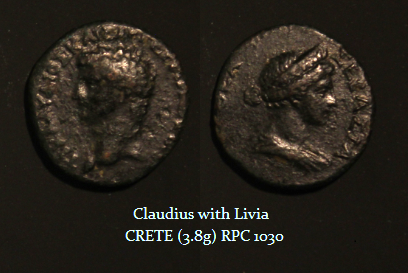
With Claudius
Æ 19 GORTYNA (Bare hd lf/Diademed Livia rt)
Æ 28 CRETE (Bare hd Claudius lf/Dr bust Livia rt)
COUNTERSTAMPS
Æ Sestertius (Countermark NCAPR (Nummus Caesare Augusto PRobatus?) Pangerl 60
Æ Dupondius (IVSTITA) “NCAPR”
Æ Dupondius (Pietas) “NCAPR”
The “NCAPR” counterstamps appear to be the most common of the era that was most likely struck upon the base metal coinage predating Nero’s reign when only gold and silver were minted in his name from the mint of Rome. Most agree that Nero applied them since they do not appear on his coins. The general conclusion has been that the translation means one of two things:
- Nero Claudius Augustus Probavit. Roughly, “with the approval of Nero Claudius, the Augustus.”
- Nero Claudius Augustus Populo Romano. Roughly, “from Nero Claudius, the Augustus, to the people of Rome.”
In the first instance, such a counter-stamp would mean the revalidation of the coins of Nero’s predecessors. The second translation would imply that it is a “congiarium” meaning it may have been a public dole given by Nero. This dole was normally welfare involving typically grain. We often see coins of later emperors celebrating this form of welfare, which is customary, so I would not subscribe to this interpretation. Moreover, most of the coins found with this counterstamp are highly worn, so it would suggest they are being reaffirmed as still valid.
Here we have a sestertius of Claudius who preceded Nero. Here, it is a barbarous imitation, which counterstamps “DV,” meaning it was devalued to a dupondius. Therefore, I subscribe to the first interpretation that the NCAPR confirmed that they were still valid and had nothing to do with the dole.

